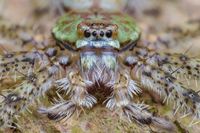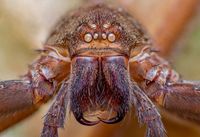...and more Photos and more Stories...
This ambush hunter, the lichen huntsman spider from the genus "Pandercetes", lives in the tropical climate zones of Australia and Asia. She sits motionless, face down, on lichen-covered tree trunks, waiting for unwary insects and other invertebrates. With a body length of approx. 15 - 20 mm and a leg span of up to approx. 8 cm, one would think that these animals should not be overlooked. However, the opposite is the case. Their color and markings make them blend into the background, so the best way to spot them is to look sideways at the tree trunks to see the spider in profile.
Now it is important to get the camera close enough to get a nice macro shot. But that's easier said than done. Swift as an arrow, these animals will scurry along the tree trunk at the slightest disturbance, often to the rear, and the search starts all over again. The specimen shown in the photo played hide and seek with me in northern Thailand near Chiang Dao for over an hour before I finally managed to take a series of photos that I was later able to put together with focus stacking.
The photo shows an exoskeleton of a huntsman spider (Sparassidae) that I found outside of Luang Prabang in Laos. In contrast to vertebrates, spiders do not have an actual skeleton, but a solid shell that protects them from external influences. In order to be able to grow, spiders therefore have to shed their skin regularly. Isn't it fascinating what nature has come up with here? A completely new spider grows inside the spider, with lenses, hair, fangs and joints and sheds its old skin like a knight taking off his armour. Jumping spiders shed their skin 5-6 times until adulthood, after that they don't molt anymore. The achievable age therefore depends heavily on the wear and tear of the exoskeleton. The visual performance decreases due to clouding or scratching of the lenses, the adhesive hairs on the feet wear out, so that hunting becomes more and more difficult. In the wild "Salticidae" are therefore rarely older than one to two years, in captivity up to about 3 years. The situation is different with tarantulas, which also shed their skin regularly as adult animals. These can be 15-20 years old.

